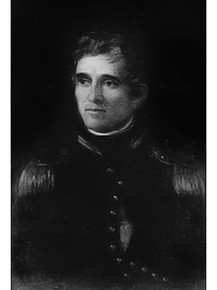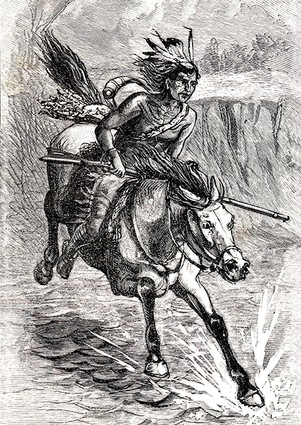Battle of Calabee Creek
Introduction
Text-to-speech Audio
Images
General John Floyd, commander of American forces at Calabee Creek

Depicted here at the Battle of Autossee, William Weatherford ultimately left Calabee Creek just hours before the battle in a dispute over strategy

Backstory and Context
Text-to-speech Audio
During the Creek War of 1813-1814, the United States military struggled to quash the Red Stick rebellion in Creek country. The Red Sticks (named for the red-painted war clubs) were a militant, religious faction within the Creek tribe who believed the needed to reject white culture and forcibly resist white encroachment on their territory. They were inspired by the Shawnee leader Tecumseh to the north, and they were led by both experienced warriors and religious prophets of their own. During the war, the Red Sticks fought not only the United States, but also fellow Creeks who allied with the Americans.
The quash the Red Sticks, the United States conducted a three front offensive, sending armies south from Tennessee, west from Georgia, and north from Mississippi Territory coast (Mississippi Territory included present day Mississippi and Alabama, and much of the war was fought within present day Alabama). The force from Georgia was commanded by Brigadier General John Floyd. In late November 1813, Floyd had struck at the Red Stick town of Autossee, and in a bloody battle, he burned the town and defeated the Red Sticks but was forced to retreat as supplies dwindled.
By the new year, Floyd was again ready to strike into Creek territory. On January 17, 1814, Floyd’s forces departed Fort Mitchell (along the Alabama-Georgia border) and invaded Creek territory in hopes of destroying the town of Tuckabatchee. Floyd’s army consisted of 1,300 Georgia militia (infantry, cavalry, and two artillery pieces), regulars of the 2nd U.S. Infantry, and a party of allied Creek and Uchee Indians.
The invasion was a miserable one for the Americans. It was cold, rainy, and the terrain was marshy and wet. Tramping along the Federal Road, the rain turned dirt into mud, and wagons floundered in the muck and mire. Just a few days into the invasion, Floyd was forced to halt to allow the roads to dry. During the pause, the Americans built an earthen fortification they dubbed Fort Hull. Rations began to run low, and morale sank. After four days, the invasion resumed.
As the army neared the Tallapoosa River, which they needed to cross, Floyd ordered his men to leave the Federal Road and march overland towards the ford. Although he likely hoped such a maneuver might allow him to catch the enemy off guard, it instead slowed his forces to a crawl. Once again, Floyd was forced to halt the expedition, this time in order to lighten the wagonloads to prevent them from sinking in the mud. As he had at Fort Hull, Floyd again ordered his men to dig earthworks during the halt. “Camp Defiance” consisted of little more than a small rectangular earthwork, barely large enough to hold the army’s equipment and men inside. It sat atop a small rise of dry ground near Calabee Creek. The army’s two cannon were placed on opposing walls, and the Creek Indians camped outside the fort.
As the Americans trudged their way towards the Tallapoosa River and Tuckabatchee, they were watched carefully by Red Stick scouts. Although General Floyd worried the enemy might be tracking his movement, he had no idea the extent to which the Red Sticks were mobilizing. On the evening of January 26, as the Americans huddled near fires for warmth, approximately 1,300 Red Stick warriors lurked in the nearby woods. They were led by a pair of experienced warriors in William Weatherford and William McGillivray, as well as two religious prophets in Paddy Walsh and High Head Jim. This represented the largest Red Stick force gathered in the war thus far, and they had a golden opportunity to strike their unsuspecting foes nearby.
Unfortunately for the Red Stick Creeks, they couldn’t decide on how best to capitalize on their opportunity. The religious prophets wanted to launch a surprise assault in the dark of night, overwhelming the American defenders. Weatherford and McGillivray blanched at the idea, worried that American artillery would inflict dreadful casualties. Instead, they argued the should allow the American army to resume its march, then strike once the Americans were strung out and unable to concentrate their forces or deploy artillery. The four leaders quarreled over the issues, and the argument grew heated. Disgusted, William Weatherford finally left the camp, taking a small number of his warriors with him (McGillivray stayed). The religious prophets would have their surprise attack on Camp Defiance.
Around 5:00 a.m. on January 27, the Red Sticks quietly advanced towards the American earthworks. Shots rang out against the pickets, and the Red Sticks roared as they broke into a charge. The camp was thrown into confusion. American militia and regulars struggled to get into line to fire on the attackers, friendly Creeks poured into the fort seeking some measure of protection, and the artillery crews rushed to their pieces. Sharp firefights erupted in the night, and casualties mounted on both sides. A small party of American pickets caught outside the fort were surrounded, only to be saved by a party of Uchee Indians under Timpoochee Barnard.
As Weatherford had worried, American artillery proved devastating. The Red Sticks fought desperately to capture the American cannon, and at one point the artillery crews clashed with the natives in hand-to-hand combat. Once able to fire, however, the two guns unleashed deadly fire on the advancing Red Sticks. Yet despite the cannon fire, the Red Sticks continued to press forward, threatening to overwhelm the fort and its defenders.
Unshaken by the attack, General Floyd coolly made preparations for a counterattack. The American infantry fixed bayonets, and upon Floyd’s order, charged back straight into the Red Sticks. Surprised by the disciplined American counterattack (and likely running short of ammunition), the Red Sticks broke and fled. The Americans stood victorious at the Battle of Calabee Creek. Parties were sent to track down retreating Red Sticks (with little success), and the allied Creeks took scalps and mutilated the fallen Red Stick bodies. Calabee Creek was a bloody engagement. The Americans suffered 18 killed, 131 wounded (over 10% of their force); the allied Indians suffered 6 killed, 15 wounded. The Red Stick suffered only 40 killed and wounded; although driven from the field, the inflicted greater damage on their enemies.
The fierce fight at Calabee Creek held important results. Following the battle, Floyd was again forced to retreat to Georgia for lack of food and supplies; upon his return, he faced criticism for having failed to inflict a more decisive victory on the Red Sticks. The Georgian campaign against the Red Sticks was finished. Yet Floyd had inadvertently done real damage to the Red Stick cause. The inability of the Red Sticks to triumph at Calabee Creek despite their strong numbers and the element of surprise deflated morale, and a number of Red Stick towns essentially dropped out of the war.
Although a difficult battle for both sides, the Creek War would rage on for two more months, until Andrew Jackson decisively defeated the Red Sticks in March at the Battle of Horseshoe Bend. Following their defeat, Jackson forced the entire Creek Nation (friendly and hostile alike) to cede over 20 million acres of land to the United States via the Treaty of Fort Jackson. The Calabee battlefield has not been preserved, and its supposed location is on private land. Unfortunately, there are no markers or remnants to commemorate its bloody place in local Alabama history.
Sources
1. Mike Bunn. "Battle of Calabee Creek." January 27, 2016. Encyclopedia of Alabama. Web. Accessed December 4, 2020. http://encyclopediaofalabama.org/article/h-3284
2. Howard T. Weir, III. A Paradise of Blood: The Creek War of 1813-1814. Yardley, PA: Westholme Publishing, 2016.
3. Joel W. Martin. Sacred Revolt: The Muscokees' Struggle for a New World. Boston: Beacon Press, 1991.
University of Georgia Libraries: http://encyclopediaofalabama.org/article/m-7404
Encyclopedia of Alabama: http://encyclopediaofalabama.org/article/m-6215
